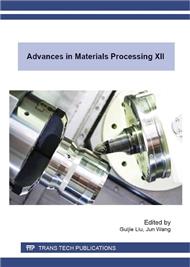p.236
p.241
p.247
p.253
p.264
p.270
p.277
p.287
p.293
Molecular Dynamics Simulation of the Propagation Property of the Interface Micro Crack in Ternary Boride Hard Cladding Material
Abstract:
The interface of the ternary boride hard cladding material consists of hard phase (Mo2FeB2) and bonding phase (α-Fe). In this paper, on the basis of the ideal interface model of Mo2FeB2 (100)/α-Fe (001) built with the molecular dynamics software, the Mo2FeB2 (100)/α-Fe (001) interface models with micro-cracks parallel with the interface, normal to the interface, and inclined to the interface have been built separately. The interface bonding energies of these four different interface models have been calculated, which shows that the interface model with the micro crack inclined to the interface has the biggest interface bonding energy, while the interface model with the micro crack parallel with the interface has the smallest bonding energy, the interface crack will be the most easily to propagate. The change rule of bonding energy of the interface model with the micro crack parallel with the interface with different lengths has been simulated and analyzed.
Info:
Periodical:
Pages:
264-269
Citation:
Online since:
July 2016
Authors:
Price:
Сopyright:
© 2016 Trans Tech Publications Ltd. All Rights Reserved
Share:
Citation:


